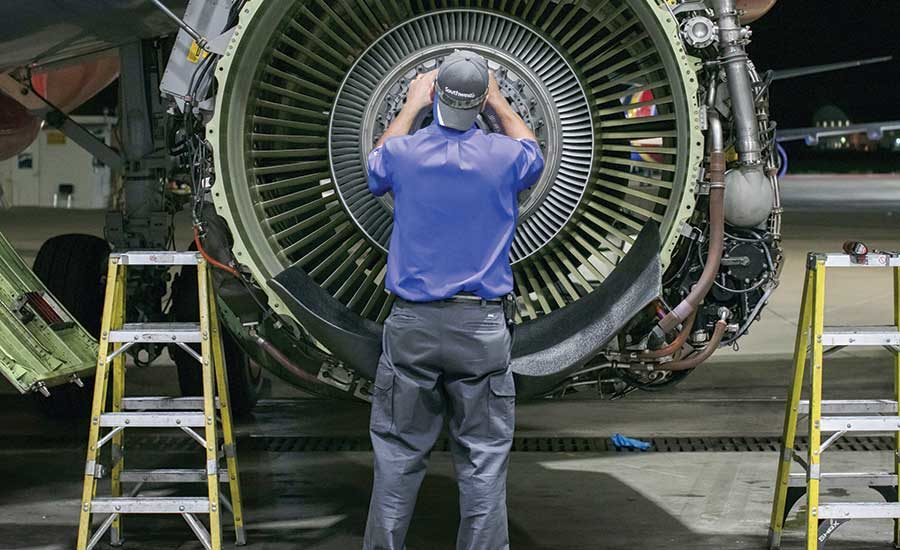
Aerospace non-destructive testing (NDT) services
MQS Technologies is a global leader in the provision of aerospace non-destructive testing (NDT) services to the aerospace industry. Our non-destructive testing (NDT) testing methods and services include the following: Ultrasonic testing (UT), Resonance testing, Phased Array, Immersion testing, Radiographic Testing (RT), X-ray flourescence testing, Eddy current testing (ET), Magnetic particle testing (MT), Penetrant testing (PT), Visual testing (VT), Leak detection testing (LT), Acoustic emission (AE), Thermography
What Is NDT (Non-Destructive Testing) for the Aerospace Industry?
In an aircraft maintenance programme, it is critical to inspect mechanical damage and determine the extent of repair work. However, it is difficult to find defects quickly in scheduled maintenance because the maintenance of aircraft must be completed within the scheduled time and the aircraft must be released in time for commercial operation.
During aircraft maintenance, ‘NONDESTRUCTWE TESTING’ (NDT) is the most cost-effective method of inspection and the only method of detecting defects. Simply put, nondestructive testing (NDT) can detect cracks or other irregularities in the airframe structure and engine components that are not visible to the naked eye.
A variety of materials are used to construct aircraft structures and assemblies, including aluminum alloy, steel, titanium, and composite materials. It would take a long time to disassemble the aircraft and then examine each component, so the NDT method and equipment selection must be quick and effective.
In the current trend of NDT application on aircraft, 70-80% of NDT is performed on the airframe, structure, and landing gears, with the remainder performed on engine and related components.
In order to keep the aircraft defect-free and to ensure a high level of quality and reliability, and as part of the inspection programme, the following NDT methods are typically used
- Liquid penetrant
- Magnetic particle,
- Eddy current
- Ultrasonic
- Radiography (x-ray/gama ray)
- Visual/Optical
- Sonic/Resonance
- Infrared Thermography.
Flaws and inconsistencies in aerospace parts can lead to catastrophic failures. This endangers the operators’ health and lives, as well as a large sum of money. Materials, parts, and components must be tested for safety and dependability at every stage of production using a variety of inspections.
Non-destructive testing (NDT) is a critical component in efforts to reduce the risk of potentially fatal failures in the aerospace industry.
What is NDT Testing?
Non-destructive testing is a technique for examining the properties of a material, component, or structure for defects without changing or damaging the part. Flaws and irregularities can be easily identified without jeopardising the subject’s integrity.
NDT methods are critical in the aerospace industry because they provide manufacturers with safety and reliability. They serve as quality control agents during aircraft testing and certification. This avoids potential revenue loss, unsafe conditions, and the need for costly repairs or part replacements as a result of failed products or equipment.
What Non-Destructive Testing Techniques are Used in the Aviation Industry?
Non-destructive testing (NDT) techniques are critical in the aviation industry for reducing costs and ensuring safety.
Safety is critical in any industry, but it is especially critical in aviation, where a minor flaw or mistake can lead to tragedy. Inadequately manufactured aerospace components can lead to tragic accidents. This endangers people’s lives and well-being, as well as large sums of money. Raw materials and components should be inspected for safety and dependability at all stages of production and maintenance using a diverse set of inspections.
NDT techniques are a critical subset of these evaluation methods used in the production, construction, and maintenance of raw materials and parts – all of which necessitate thorough analyses capable of detecting any defects in a test subject.
NDT techniques are also used in the evaluation and certification of aircraft parts as a quality assurance measure. Flaws or inconsistencies that are overlooked during the manufacturing process can lead to costly repairs and part replacements that deplete a company’s finances. If serious damage occurs, to the point where a part or an entire aircraft section must be discarded, the cost skyrockets.
NDT techniques can also be used during scheduled maintenance to detect flaws and the effects of wear. Problems can then be dealt with as they arise. However, resolving a problem once does not guarantee that it will not resurface later.
With this in mind, the non-destructive techniques listed below are commonly used in the aviation industry.
Probably, the aerospace industry leads the world in the development of new materials and fabrication techniques on a regular basis in order to improve safety, efficiency, and cost-effectiveness. Simultaneously, inspection techniques to monitor their integrity are being developed. For example, the growing use of composites in modern commercial aircraft construction has fueled rapid development in ultrasonic technique C scan presentation. It can detect defects deep within composites by creating three-dimensional images of the structures and any irregularities within the test item.
Only by employing appropriate non-destructive testing techniques can the benefits of advanced materials science be fully realised.
How MQS Technologies Support Aerospace Non-Destructive Testing
MQS Technologies custom Services for the aerospace industry, such as cleaning baskets and custom carts. Most NDT methods, particularly those that require the use of fluids, such as liquid penetrant testing, necessitate the use of aerospace NDT dipping and drying baskets.
With us, your test pieces will remain intact, with no risk of damage or inconsistency.
